|
|
Datalogic Memor
A speedy, slender pocket-size (yet rugged) mobile computer with laser scanner or imager that also works as a cellphone and communicator
(by Conrad H. Blickenstorfer -- view PDF version)
What if you need a tough, rugged, state-of-the-art industrial-strength mobile computer with barcode scanning capabilities, but want the absolute minimal bulk and weight? And, oh, if it could also work as a phone, that'd be great. Well, that's what Datalogic designed its Memor for. To give you an idea of just how small and handy the Memor is, below is the entire current lineup of Datalogic handhelds:

The Memor weighs just nine ounces and measures 6 x 2.2 x 1.57 inches -- barely larger than the smallest cellphones were just a few short years ago. Yet, it is a full-function Windows Mobile 6.1 (or Windows CE 5.0) device powered by a speedy processor and having integrated 802.11b/g WiFi and Bluetooth Class II with EDR. The device also includes Quad-Band GSM/EDGE functionality for voice and data communication.
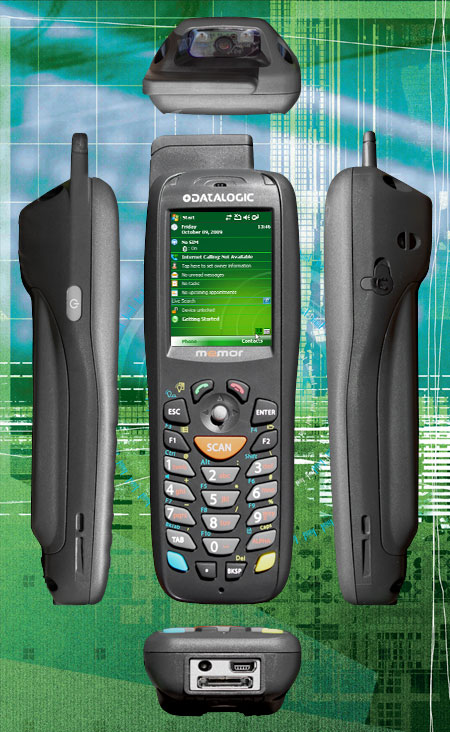 The Datalogic Memor could be described as an industrial data capture PDA that also offers full phone functionality and "shirt pocket" convenience thanks to its relatively small size and weight. The Datalogic Memor could be described as an industrial data capture PDA that also offers full phone functionality and "shirt pocket" convenience thanks to its relatively small size and weight.
Technologically up-to-date, this latest Memor uses Marvell's PXA310 processor that is part of Marvell's powerful yet frugal PXA3xx family of application processors. Capable of running at clock speeds up to 624MHz, the PXA310 provides very good speed, hardware video acceleration, DRM security and combines them with low-power modes and the ability to dynamically adjust voltage and frequency for optimal battery life.
The image to the right shows the unit from the front and from all four sides. Going around the Datalogic Memor:
- The top of the unit features the barcode scanner window and a thin antenna extension.
- On the left side is the on/off button.
- On the right side is a sealed headphone port.
- The front side has, in addition to the screen and keypad, the microphone, speaker, and two indicator lights. The left light signals a good scanner read or it can be programmed to do something else, and the right one shows charging status (red when charging, then goes green once charging is completed).
- On the bottom are a power jack, a mini-B USB port, and a communication/charger connector for use with the cradle.
- The backside of the Memor houses the battery with the SIM and microSD card slots underneath. There is also a hand strap loop and a sealed speaker.
The Memor can be ordered with either one of two scanner options. For applications that require rapid capture speed and a wide depth of field, a laser scanner is the answer. Datalogic's patented Green Spot "good read" feedback makes using the laser intuitive and it reduces errors. 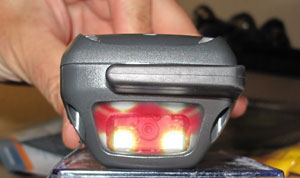 If an application requires reading a wide variety of 1D and 2D codes and also needs signature capture or image documentation, the 2D scan engine option is the answer. Our tester came with the 2D imager that uses a very clever crosshair aiming system that makes it very easy to capture codes. There is a scanner configuration utility that easily lets you set and finetune scanner and reader parameters down to significant detail. If an application requires reading a wide variety of 1D and 2D codes and also needs signature capture or image documentation, the 2D scan engine option is the answer. Our tester came with the 2D imager that uses a very clever crosshair aiming system that makes it very easy to capture codes. There is a scanner configuration utility that easily lets you set and finetune scanner and reader parameters down to significant detail.
The Memor is an exceptionally well-built unit. It consists of a very sturdy magnesium chassis sitting inside a polycarbonate plastic housing that has an upper and a lower half. The two halves are sealed using a tongue and groove system with a pressure seal inside the groove. 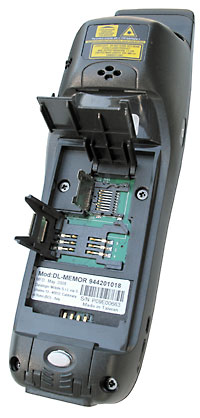 The main circuit board as well as the imager assembly are all securely mounted onto the inner magnesium chassis. The 2D imager itself is mounted onto a magnesium subframe. Sometimes when we examine the inside of a device, things are haphazardly arranged or just sort of sit there. Not in the Memor. Nothing is loose, or will ever come loose. The main circuit board as well as the imager assembly are all securely mounted onto the inner magnesium chassis. The 2D imager itself is mounted onto a magnesium subframe. Sometimes when we examine the inside of a device, things are haphazardly arranged or just sort of sit there. Not in the Memor. Nothing is loose, or will ever come loose.
The Memor's expansion slots are mounted directly on top of the motherboard, and they are accessible through the battery compartment. The slots are located beneath a plastic flip-up cover. Getting cards into and out of the slots is a little delicate as it requires sliding the slot cover towards its hinge, flip it up, insert the card, rotate it back down and slide the slot cover back to lock it in place and make secure contact. No big deal, but perhaps a little finicky for an industrial device.
The battery itself fits very snuggly into the compartment, taking over part of the sealing. On top of that goes the battery cover which snaps into place and has its own pressure seal. The lever that secures the battery cover has a silver button that holds the lever in place. The button depresses a bit too easily, so that the battery cover could be released by accident.
The Memor's display is quite small, measuring just 2.2 inches diagonally. That's smaller even than most LCDs on consumer digital cameras, and a lot smaller than the 3.5 or 3.8 inch displays found on most handhelds. However, the display is so sharp and bright that it's actually very readable. Even though it only displays at the standard 240 x 320 QVGA resolution, on a display this small that means a razor-sharp 182 dots per inch. That is sharper than the Apple iPhone! Combine that high resolution with a rock-solid LCD and even tiny text is perfectly readable.
As is the case with most PDAs, the Memor's display remains quite usable outdoors. It is only in direct sunlight that the screen becomes a bit difficult to read. There can also be reflections from the soft touch screen cover membrane, and fingerprint smudges become visible. Brightness can be adjusted via control panel in five steps.
The Datalogic Wavelink alliance
In 2008, Wavelink Corporation and Datalogic Mobile formed a strategic alliance that brought, at no additional cost, pre-licensed Wavelink Terminal Emulation software to Datalogic mobile devices. Wavelink Avalanche is a mobile device management solution that provides complete visibility and control of mobile units from a central console. Companies that have a large number of mobile systems in the field can use it for the configuration, deployment, and management of all those mobile devices. This can streamline operations, enforce wireless network and security configurations, and make sure that policies are adhered to. Avalanche allows to define and control what each user or user group is authorized to access and manage by assigning rights according to job functions or locations. Wavelink Avalanche is pre-licensed on all Datalogic Windows Mobile and Windows CE devices, including the Memor. When users purchase a device and register it with Wavelink they even get a year of free maintenance. In essence, Wavelink terminal emulation adds some of the most popular emulation types including 5250, 3270, VT100, VT110, and VT220.
The Memor also includes Wavelink Avalanche, which is a mobile device management solution that provides complete visibility and control of mobile units from a central console. Companies that have a large number of mobile systems in the field can use it for the configuration, deployment, and management of all those mobile devices. This can streamline operations, enforce wireless network and security configurations, and just generally make sure that policies are adhered to. Avalanche allows to define and control what each user or user group is authorized to access and manage by assigning rights according to job functions or locations.
Ruggedness
The Datalogic Memor is a tool for jobs in the field, in warehouses, on shop floors, in retail environments and many other settings. It will not always be babied and it may occasionally get dropped or rained on. The unit is built to handle that sort of work environment. It is structurally very sound, sort of like cellphones used to be (remember the Motorola "brick"?) before they became tiny fragile and jewel-like fashion items.
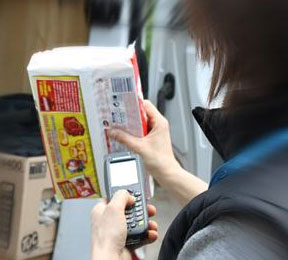 The Memor can handle a wide 32 to 122 degree Fahrenheit operating temperature range. That means it can be used in most settings, but it's not designed for use in freezers or freezing outdoor environments. The Memor can handle a wide 32 to 122 degree Fahrenheit operating temperature range. That means it can be used in most settings, but it's not designed for use in freezers or freezing outdoor environments.
With regard to sealing against solids and liquids, the Datalogic Memor offers IP54 protection. What does that mean? The first number refers to protection against solids. "5" means protection against dust but with limited ingress. The second number means protection against liquids. "4" means the unit is protected against water spray from all direction, with limited ingress permitted.
As far as resistance to shock goes, the unit can survive a four-foot drop. For most users that means the Memor won't get hurt if it slips out of your hands while it's being used. Datalogic also sells a soft case with a belt clip that offers a bit of extra protection and a clear plastic cover over the keypad.
OS: Windows Mobile or Windows CE
Our review Datalogic Memor came with Microsoft Windows Mobile 6.1, which means it included a variety of Microsoft standard mobile applications and utilities. Among them are mobile versions of Word, Excel, PowerPoint and OneNote. It also includes PIM applications, mail, web browsing, Windows Messenger, a picture viewer and a good number of control panels.
Depending on your intended application, Datalogic can ship the Memor with friendly Windows Mobile or the more industrial Windows CE 5.0. It's usually a software-driven judgment call and the nomenclature can be a bit confusing. These days, Microsoft differentiates between Windows Embedded CE and Windows Mobile. Windows Embedded CE is a scalable 32-bit OS designed for intelligent devices ranging from enterprise tools such as industrial controllers, communications hubs, and point-of-sale terminals to consumer products such as cameras, phones, and home entertainment devices. Windows Mobile, on the other hand, is a platform that is also based on Windows Embedded CE, but has the more consumer-oriented look and feel and features required for PDAs and smartphones. A device like the Memor could be used either with Windows CE or Windows Mobile, depending on the intended application. In general, customers who design their own custom applications may lean towards a Windows CE implementation whereas customers with more general needs prefer the friendlier Windows Mobile platform.
Below are screen captures of some of the Memor's displays. To the left is the "Today" screen that provides a starting point and one-touch access to many functions. In the middle is Windows Mobile's version of the Windows Control Panel with some three dozen individual utilities grouped into the Personal, System, and Connections screens. To the right are the Office Mobile icons.
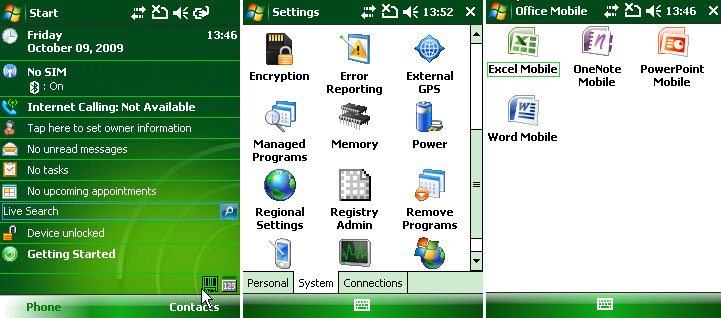
Below are three more Windows Mobile screen captures. To the left is the Wireless Manager that provides one-click on/off access to all onboard radios and their settings panels. In the middle is a bar code scanner utility screen. On the right is the standard phone app layout. Since the Memor has a physical keypad, the onscreen keypad is not necessary to make calls and you can make it disappear.
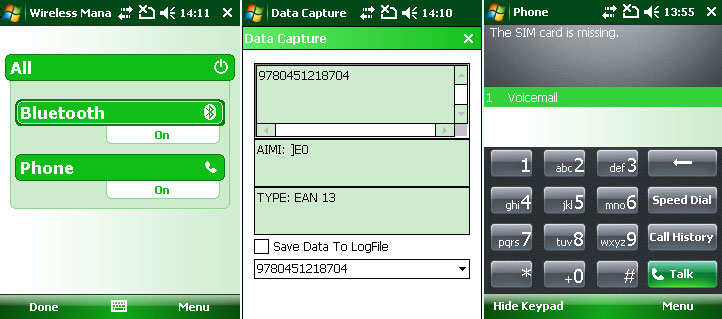
While Microsoft's smallest OS has always lived in the shadow of "full" Windows, CE is a multi-threaded, multi-tasking, fully preemptive OS environment that had been targeted from the start specifically for low-power, economical hardware with limited resources. Windows CE supports a rich subset of Microsoft Win32 APIs and many additional programming interfaces but remains a curious animal. Unloved by most, the platform nevertheless became the de-facto standard for industrial and vertical market handhelds, and that seems unlikely to change anytime soon. The look and feel of Windows Mobile really hasn't changed much in a good decade, so while it may have industrial-strength underpinnings, it feels dated compared to the Apple iPhone or the Palm Pre. Microsoft recently released Windows Mobile 6.5 with a new user interface that seeks to copy the iPhone, but the underpinnings are largely unchanged. Datalogic intends to offer Windows Mobile 6.5 on the Memor in middle 2010.
Using the Memor as a phone
While almost everyone has a cellphone these days, there are times when having phone functionality in a handheld computer makes sense: everything is combined into one device, there may be accounting/reimbursement issues, or a standard cellphone may not be rugged enough. That's probably why Datalogic made the Memor a fully functional phone as well as a handheld computer. How does it work? 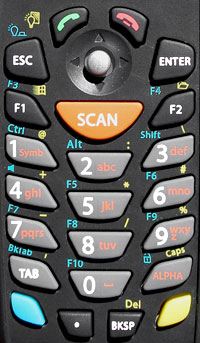 As long as you have a SIM card and an activated account for it, the Memor can be used as a smartphone, and this is actually one area where Windows CE shines. It has had very good phone extensions going back as far as 2002 when Microsoft introduced the Pocket PC Phone Edition. As long as you have a SIM card and an activated account for it, the Memor can be used as a smartphone, and this is actually one area where Windows CE shines. It has had very good phone extensions going back as far as 2002 when Microsoft introduced the Pocket PC Phone Edition.
During our review I used the SIM from one of my AT&T phones in the Memor and it worked right off the bat. The Memor's speaker is strong and voice quality is better than in many of today's tiny, tinny cellphones. In addition, the phone extensions in Windows Mobile are nicely integrated deeply into the device and quite useful
To use the Memor as a phone, you push the green phone button or select "Phone" from the menu. The phone application shows the last call, an onscreen keypad, and access to call logs and speed dial. The call log provides summary info about the number of calls and call time. Individual call log entries provide one-button call-back or SMS messaging as well as access to any notes that may be attached to a call. Or you can create a new Contacts entry automatically. If you use the speakerphone function, you can even take notes during a call. The note will have the caller's name, the phone number, and the time of the call already on it. Volume for the phone can be set separately from the system itself and you can make conference calls.
All of this means that the Datalogic Memor can be used as a full-function phone in addition to everything else it does. And unlike many other Windows Mobile devices that include phone functionality, the Memor's keypad and clearly marked phone and function buttons make it easy to use as a phone. About the only thing that is missing is Tegic T9 predictive text entry.
Note the blue and yellow "modifier" keys on the picture to the right. They are used to access keys and functions that would otherwise not fit onto such a small keypad. A tiny icon on the bottom right of the screen shows if one of the modifier keys has been depressed, or if the unit is in alpha or numeric mode.
Data entry methods
For data entry, Windows Mobile offers a wealth of options. In addition to the Memor's physical keypad, there is a nice pop-up keyboard and there are also no fewer than three different ways of recognizing text. To see how it works, check the screen captures below. They are clockwise from the upper left:
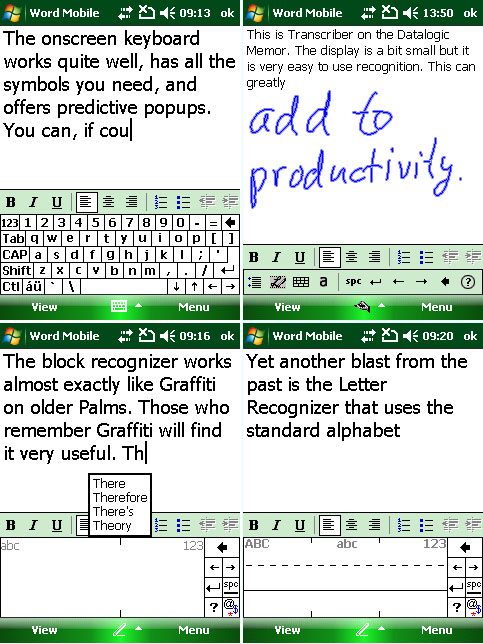
- Onscreen keyboard, that is used with the stylus and works very well. Individual keys on the small screen are a bit small but workable. You can shift the keyboard into one with numbers and symbols, and you can also shift into one that shows foreign characters. The Windows Mobile keyboard may not be pretty, but it is very functional.
- Transcriber, which is a full-function handwriting recognition system that also goes way back almost to the beginning of PDAs more than 15 years ago. Microsoft bought the rights to it a number of years ago and it's been part of Windows Mobile ever since. Learn how to use it, and it works exceptionally well.
- Letter Recognizer, which recognizes individual letters instead of whole words, but uses the standard alphabet instead of the slightly modified one of the Block Recognizer. And whereas the Block Recognizer lets you shift case, the Letter Recognizer, which goes back to a product called "Jot" by (CIC) Communication Intelligence Corporation, has different data entry boxes for upper case, lower case and numerals. I have always found it a bit cumbersome, but it has its supporters.
- Block Recognizer, which uses the special Graffiti alphabet Palm invented in the 1990s. The idea here is that almost all letters are "unistrokes," or consisting of a single uninterrupted stroke, which makes them easy to recognize for the computer. The slightly abstracted alphabet is quite easy to learn. Millions used it on Palm Pilots.
Any of those input methods, once mastered, work very well. The many different ways in which you can enter data into documents is definitely a strong point of Windows Mobile. And for those who need to type a lot of data into the Memor there's always a standard keyboard. Yes, if you have the proper cable you can connect a standard USB keyboard directly into the Memor.
Accessories
Our review Memor came with a number of handy accessories. I already mentioned the softcase with belt clip. There is also a powered vehicle dock with serial connectivity. It can be mounted in numerous ways via standard RAM-Mount components and adjustable arms. The powered vehicle dock can handle anything from 10-32VDC. For worldwide use there are a number of international power plug adapters that fit into the Memor's small power brick. For office use there is a single unit desk cradle that provides USB and serial connectivity and has space for charging a spare battery.
Summary: Datalogic Memor
The Datalogic Memor is a very small and compact handheld that can be used as a mobile computer, as a smartphone, and as a data capture device. Despite its considerable power, the Memor is hardly bigger than a cellphone, weighs just nine ounces, and fits into most pockets. 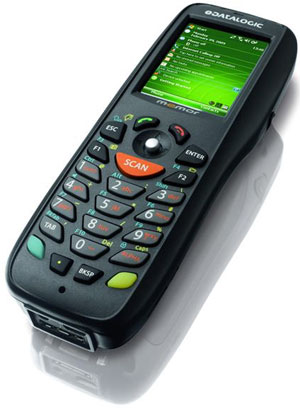 Depending on its intended use, the Memor comes with either the user-friendly Windows Mobile or the more industrial Windows CE for custom applications.
Depending on its intended use, the Memor comes with either the user-friendly Windows Mobile or the more industrial Windows CE for custom applications.
The Memor comes in a variety of different models that may have Bluetooth, 802.11b/g WiFi, GSM/EDGE voice/data capability, a standard or extended life battery, and either a 1D laser or 2D imager. This means that the Memor can function as a phone, including data communications, email, web browsing, and messaging.
Equipped with a small (2.2 inches diagonally) but very sharp and bright QVGA touch screen, the Memor can be operated either via stylus or via its multi-function 23-key keypad with dedicated phone and scan keys as well as programmable keys. The Memor is quick and responsive thanks to a powerful 624MHz Marvel PXA310 processor. Onboard storage can be expanded through its user-accessible micro-SD Card slot.
For software development, there is the standard Windows CE SDK as well as Wavelink terminal emulation, and a variety of Datalogic and Wavelink utilities.
Datalogic Memor highlights:
- Small, light and handy
- Available either with Windows Mobile or Windows CE
- Based on speedy, power-efficient Marvell PXA310 processor
- Large, clearly marked buttons on backlit keypad
- Choice of 1D laser or 2D imager
- Multiple data entry methods (even external standard keyboard)
- Good onboard wired connectivity via dock and cables
- Rugged enough for the job
- Full GSM/EDGE voice/data capabilities
But keep in mind:
- 2.2-inch display is very sharp, but text is tiny.
- No on-device garage for the stylus (it fits into a loop on the wrist-strap)
– Conrad H. Blickenstorfer, October 2009
|
Datalogic Memor Specifications
|
| Added/changed |
Added 10/2009
|
| Type |
Pocket-size flashlight-style handheld with phone functionality
|
| Processor |
Marvell PXA310 application processor |
| Processor speed |
624 MHz |
| OS |
Windows CE 5.0 or Windows Mobile 6.1 |
| RAM/ROM |
128MB/256MB |
| Display |
Reflective TFT touch screen with LED backlight |
| Display size/res |
2.2"/240 x 320 |
| Digitizer/Pens |
resistive touchscreen/1 |
| Keyboard |
Backlit 23 rubber key keypad |
| Slots |
1 micro-SD Card, SIM card |
| Housing |
unknown |
| Navigation |
5-position joystick, stylus |
| Temperature |
32 to 122F |
| Humidity |
10 to 80% non-condensing for temperatures < 100 °F |
| Shock |
4-foot drop |
| Vibration |
unknown |
| Enclosure Class |
IP54 |
| Size (inches) |
2.2 x 6.0 x 1.6 inches (Edge version: 6.5 x 2.2 x 1.6 inches) |
| Weight |
9.3 ounces as tested with extended battery (8.1 ounces with standard battery) |
| Power |
Removable, rechargeable battery pack 3.7V 1100 or 2000 mAh (4.1/7.4 Watt hours); alkaline batteries compatible |
| Code list laser |
UPC A, UPC E, EAN 8, EAN 13, Code 39, Code 39 Full ASCII, Code 32, Interleaved 2 of 5, Industrial 2 of 5, Matrix 2 of 5, Code 128, EAN 128, Codabar, MSI, Plessey, Code 93, Code 11, GS1 Databar
|
| Code list imager |
UPC A, UPC E, EAN 8, EAN 13, UPC/EAN/JAN, Interleaved 2 of 5, Code 39, Code 39 Full ASCII, Codabar, Code 128, EAN 128, Code 93, GS1 Databar, PDF417, DataMatrix, QR, MacroPDF, RSS, POSTNET, PLANET, Japan Post, Australia Post, KIX Code, Royal Mail Code (RM4SCC)
|
| Communication |
Integrated Summit Data 802.11b/g with CCX v4 certification or Quad-Band GSM/EDGE 850/900/1800/1900 for voice and data communication; Bluetooth Class 2 with EDR
|
| Interface |
mini-USB (Host 1.1 and Client 2.0), RS232, standard laser scanner or 2D imager/bar code reader |
Price |
Inquire |
| Contact |
Datalogic Mobile www.datalogic.com -- 1-800-929-7899, 1-541-868-3619 |
|
|



